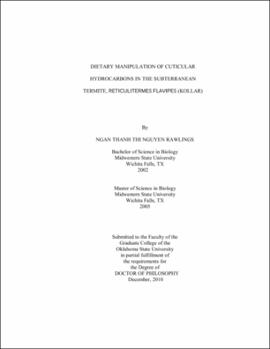| dc.contributor.advisor | Dillwith, Jack W. | |
| dc.contributor.author | Nguyen Rawlings, Ngan Thanh Thi | |
| dc.date.accessioned | 2013-11-26T08:23:48Z | |
| dc.date.available | 2013-11-26T08:23:48Z | |
| dc.date.issued | 2010-12 | |
| dc.identifier.uri | https://hdl.handle.net/11244/6750 | |
| dc.description.abstract | Scope and Method of Study: The purpose of this study was to examine the effects of dietary hydrocarbon in Reticulitermes flavipes. Pure hydrocarbons were added to filter paper and fed to R. flavipes for two weeks followed by a chase period. Cuticular and internal hydrocarbons were extracted and isolated. Cuticular and internal hydrocarbons were analyzed using a HP 5890 gas chromatograph. Hydrocarbons were identified using internal standard and Agilent ChemStation software. | |
| dc.description.abstract | Findings and Conclusions: Cuticular and internal hydrocarbon profiles were altered with dietary hydrocarbons. Dietary hydrocarbons that were used included n-alkanes, alkenes, and methyl-branched hydrocarbons and were applied as a single hydrocarbon, a combination of hydrocarbons, or at different concentrations. Dietary hydrocarbons were incorporated into both hydrocarbon pools within the first 24 hours of feeding and were still in the termite system at 63 days. Results show that dietary hydrocarbons can be transferred from treated termites to their non-treated nestmates through their social behaviors. Altered cuticular hydrocarbon profiles affected cuticular water balance in desiccation experiments. Treated termites had a significantly higher total body water loss than the control termites and suffered 100% mortality after 24 hours. Control termites only had 50% mortality after 24 hours in the desiccation experiments. Cuticular permeability (CP) values indicated that adding a short-chain hydrocarbon or alkene and methyl-branched hydrocarbon to R. flavipes's diet caused a greater cuticular water loss compared with the control termites in the first 2 hours. Altered cuticular hydrocarbon profiles did not have an effect at a moderate relative humidity (55 degrees C) but did confirm results from the desiccation experiment where 100% mortality was observed after 24 hours. Further studies need to be conducted to examine how altered cuticular hydrocarbons affect termite behavior and water balance in field conditions, and whether dietary hydrocarbons can be implemented for termite management. | |
| dc.format | application/pdf | |
| dc.language | en_US | |
| dc.rights | Copyright is held by the author who has granted the Oklahoma State University Library the non-exclusive right to share this material in its institutional repository. Contact Digital Library Services at lib-dls@okstate.edu or 405-744-9161 for the permission policy on the use, reproduction or distribution of this material. | |
| dc.title | Dietary manipulation of cuticular hydrocarbons in the subterranean termite, Reticulitermes flavipes (Kollar) | |
| dc.contributor.committeeMember | Payton, Mark E. | |
| dc.contributor.committeeMember | Kard, Bradford M. | |
| dc.contributor.committeeMember | Greenwood, Carmen | |
| osu.filename | NguyenRawlings_okstate_0664D_11095.pdf | |
| osu.accesstype | Open Access | |
| dc.type.genre | Dissertation | |
| dc.type.material | Text | |
| dc.subject.keywords | cuticular hydrocarbons | |
| dc.subject.keywords | cuticular permeability | |
| dc.subject.keywords | dietary manipulation | |
| dc.subject.keywords | reticulitermes flavipes | |
| thesis.degree.discipline | Entomology | |
| thesis.degree.grantor | Oklahoma State University | |
